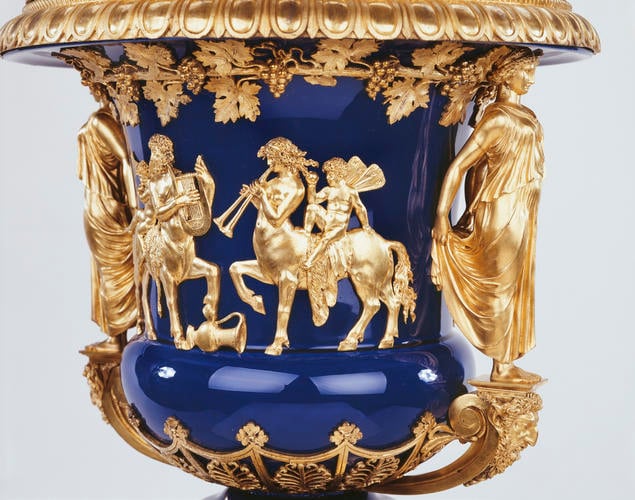Mounted pot-pourri vase c. 1812
Hard paste porcelain, dark blue ground, gilded decoration and gilt bronze | 77.2 x 34 cm (parts .a and .b together) | RCIN 3211
-
This magnificent vase, of dark blue ground, is fitted with gilt bronze mounts. These comprise a pierced cover, top ring, foot ring and square plinth, a pierced saucer-shaped mount in which the vase section lodges, a frieze of centaurs composed of two low reliefs with, above, a vine trail, draped female figure handles standing on console supports, and an upright square base decorated on the front and back with a palm wreath tied with a ribbon.
The porcelain vase, which has a separately moulded stem and foot, is of Medici shape. It contains a bronzed metal container; its bombé cover, which is pierced with a repeating pattern of stars and stylised leaves, is fitted with an elaborate knob. The knob is in the form of a foliate seed pod on a radiating base composed of four leaves, each outlined with a flat moulding, alternating with scrolling anthemion motifs on slender stems. Running round the rim of the vase is an entwined-rope motif above an egg-and-dart moulding and vine trail laden with grapes. The body of the vase sits in a foliate mount of fret design with, in each compartment, an anthemion. Partly overlying it at either end is the projecting scrolled support for the handles, which is chased with a satyr head below a platform, on which stands the draped female figure, with arms stretched out behind her holding the folds of her gown. The low-relief scene is based on the carved decoration of a Roman funerary monument, the altar of Amemptus, which is in the Louvre. It represents Cupid, the emblem of the heart, and Psyche, the personification of the soul, riding centaurs confronting one another.
Text adapted from French Porcelain: In the Collection of Her Majesty The Queen, London 2009Provenance
Purchased by George IV from Pierre-Philippe Thomire (maître-fondeur, 1772–1843). The vase was entered by Benjamin Jutsham in the Carlton House receipts’ ledger on 24 June 1812: ‘[Received from] Mr Thomire A Blue Seve porcelaine Vase, mounted on an Or Molu Pedestal ornamented with wreaths, the China Vase is ornamented with Centaurs in Or Molou 2 Feet 6 Inches high Large Blue Velvet Room’.
In the engraving by Daniel Havell after Charles Wild, which was published on 1 October 1816, the vase is shown in a window embrasure on a tripod stand by Thomas Tatham dating from c.1811. By 1818 the vase had been removed to the Blue Velvet Closet, where it was illustrated by Wild in an engraving by R. Reeve dated 1 August 1818 and subsequently described in the inventory drawn up in 1826: ‘No.42. A magnificent blue Seve Porcelain Vase, with pierced ormolu top, egg and tongue border, handles of Female Figures, standing on scrolled Satyr masks, embossed Centaurs, vines fruited and honeysuckles on the body of the Vase, and wreathed moulding, all of ormolu, on a square ormolu plinth with chased leaf and cable borders, and wreaths on two pannels – 2. f. 7 – high’.
Pierre-Philippe Thomire was the outstanding Parisian bronzeur and gilder of the early nineteenth century. He supplied finely chased mounts to leading Parisien ébénistes for furniture, clocks and the Sèvres porcelain factory. He was much patronised by Napoleon who made him Ciseleur de l'Empereur. His work represents some of the finest examples of Empire style.
In 1804 he acquired business of the marchand-mercier, Martin-Eloi Lignereux. The company employed a large workforce in a workshop at rue Boucherat and a showroom at rue Taitbout, from where Thomire retailed a large range of decorative objects inspired by antiquity including candelabra, extravagant centrepieces, clock cases and monumental Greek and Roman style urns and vases.
Thomire collaborated with three partners, renaming the business for a time Thomire, Duterme et Cie. The business suffered as a result of France's continuing European hostilities and to avoid bankruptcy the firm was granted dispensation to trade with the Prince Regent . Soon after 1815 the partnership with Duterme was dissolved and, under the old style, Thomire et Cie thrived once more under the restored Bourbons.
Thomire retired in 1823 and his two sons-in-law, Louis-Auguste-Cesar Carbonelle and André-Antoine Beauvisage, continued the business until 1852. Thomire continued to work as a sculptor and exhibited regularly at the Salon until 1834. -
Creator(s)
(porcelain manufacturer)(bronze maker)(nationality)Acquirer(s)
-
Medium and techniques
Hard paste porcelain, dark blue ground, gilded decoration and gilt bronze
Measurements
77.2 x 34 cm (parts .a and .b together)
27.2 x 33 cm (whole object, diameter)
12.5 x 13.7 cm (excluding mounts)
Place of Production
Sèvres [France]











